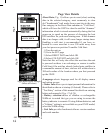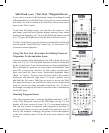
24
(i.e., data identied according to their location). In practical use, GIS often refers to the
computer system, software, and the data collection equipment, personnel, and actual
data.
•Global Positioning System (GPS): A global navigation system based on 24 or more
satellites orbiting the earth at an altitude of 12,000 statue miles and providing very precise,
worldwide positioning and navigation information 24 hours a day, in any weather. Also called
the NAVSTAR system.
•GoTo: A route consisting of one leg, with your present position being the start of the route
and a single dened waypoint as the destination.
•Greenwich Mean Time (GMT): The mean solar time for Greenwich, England, which is
located on the Prime Meridian (zero longitude). Based on the rotation of the earth, GMT is
used as the basis for calculating standard time throughout most of the world.
•Grid: A pattern of regularly spaced horizontal and vertical lines forming square zones on
a map used as a reference for establishing points. Grid examples are UTM, MGRS, and
Maidenhead.
•Heading: The direction in which a vehicle is moving. For air and sea operations, this may
differ from actual Course Over Ground (COG) due to winds, currents, etc.
•Initialization: The rst time a GPS receiver orients itself to its current location and collects
almanac data. After initialization has occurred, the receiver remembers its location and
acquires a position more quickly because it knows which satellites to look for.
•Latitude: A position’s distance north or south of the equator, measured by degrees from
zero to 90.One minute of latitude equals one nautical mile..
•Leg: A portion of a route consisting of a starting (from) waypoint and a destination (to)
waypoint. A route that is comprised of waypoints A, B, C, and D would contain three legs.
The route legs would be from A to B, from B to C, and from C to D.
•Longitude: The distance east or west of the prime meridian (measured in degrees). The
prime meridian runs from the north to south pole through Greenwich, England.
•Magnetic North: Represents the direction of the north magnetic pole from the observer’s
position. The direction a compass points.
•Map Display: A graphic representation of a geographic area and its features.
•Nautical Mile: A unit of length used in sea and air navigation, based on the length of one
minute of arc of a great circle, especially an international and U.S. unit equal to 1,852
meters (about 6,076 feet).
•Navigation: The act of determining the course or heading of movement. This movement
could be for a plane, ship, automobile, person on foot, or any other similar means.
•North Up Orientation: Fixes the GPS receiver’s map display so north is always xed at the
top of the screen.
•Position: An exact, unique location based on a geographic coordinate system.
•Position Fix: The GPS receiver’s computed position coordinates.
•Position Format: The way in which the GPS receiver’s position will be displayed on the
screen. Commonly displayed as latitude/longitude in degrees and minutes, with options for
degrees, minutes and seconds, degrees only, or one of several grid formats.
Glossary


















